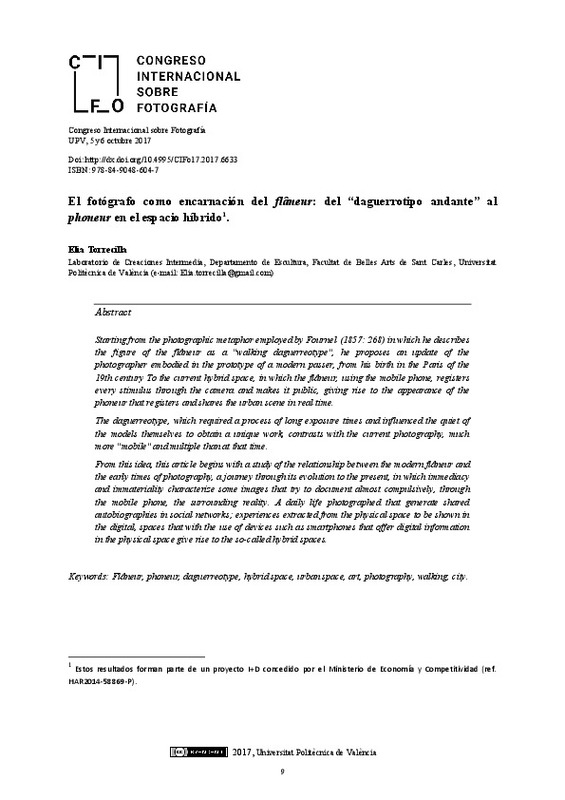JavaScript is disabled for your browser. Some features of this site may not work without it.
Buscar en RiuNet
Listar
Mi cuenta
Estadísticas
Ayuda RiuNet
Admin. UPV
El fotógrafo como encarnación del flâneur: del “daguerrotipo andante” al phoneur en el espacio híbrido
Mostrar el registro completo del ítem
Torrecilla Patiño, E. (2018). El fotógrafo como encarnación del flâneur: del “daguerrotipo andante” al phoneur en el espacio híbrido. En I Congreso Internacional sobre fotografía. Nuevas propuestas en investigación y docencia de la fotografía. Editorial Universitat Politècnica de València. 9-22. https://doi.org/10.4995/CIFo17.2017.6633
Por favor, use este identificador para citar o enlazar este ítem: http://hdl.handle.net/10251/114843
Ficheros en el ítem
Metadatos del ítem
| Título: | El fotógrafo como encarnación del flâneur: del “daguerrotipo andante” al phoneur en el espacio híbrido | |
| Autor: | Torrecilla Patiño, Elia | |
| Fecha difusión: |
|
|
| Resumen: |
[EN] Starting from the photographic metaphor employed by Fournel (1857: 268) in which he describes
the figure of the flâneur as a "walking daguerreotype", he proposes an update of the
photographer embodied in the prototype ...[+]
[ES] Partiendo de la metáfora fotográfica empleada por Fournel en 1857 en la que describe la figura del
flâneur como “daguerrotipo andante”, se propone una actualización del fotógrafo encarnado en el
prototipo de paseante ...[+]
|
|
| Palabras clave: |
|
|
| Derechos de uso: | Reconocimiento - No comercial - Sin obra derivada (by-nc-nd) | |
| ISBN: |
|
|
| Fuente: |
|
|
| DOI: |
|
|
| Editorial: |
|
|
| Versión del editor: | http://ocs.editorial.upv.es/index.php/CIFo/CIFo17/paper/view/6633 | |
| Título del congreso: |
|
|
| Lugar del congreso: |
|
|
| Fecha congreso: |
|
|
| Código del Proyecto: |
|
|
| Agradecimientos: |
|
|
| Tipo: |
|








